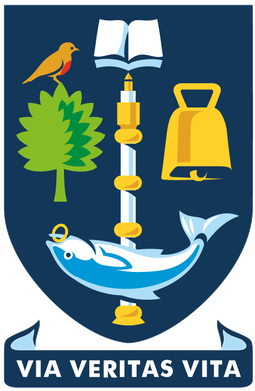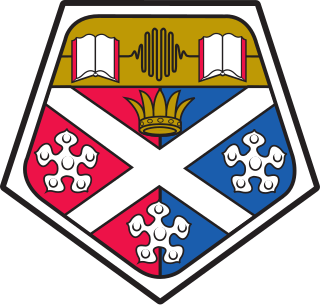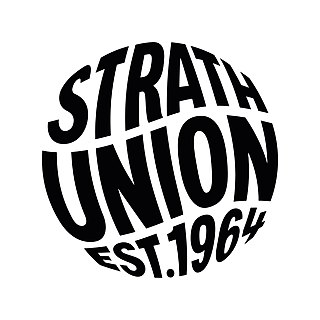
The University of Glasgow is a public research university in Glasgow, Scotland. Founded by papal bull in 1451 [O.S. 1450], it is the fourth-oldest university in the English-speaking world and one of Scotland's four ancient universities. Along with the universities of St Andrews, Aberdeen, and Edinburgh, the university was part of the Scottish Enlightenment during the 18th century. Glasgow is the largest university in Scotland by total enrolment and with over 19,500 postgraduates the second-largest in the United Kingdom by postgraduate enrolment.

The University of Strathclyde is a public research university located in Glasgow, Scotland. Founded in 1796 as the Andersonian Institute, it is Glasgow's second-oldest university, having received its royal charter in 1964 as the first technological university in the United Kingdom. Taking its name from the historic Kingdom of Strathclyde, its combined enrollment of 25,000 undergraduate and graduate students ranks it Scotland's third-largest university, drawn with its staff from over 100 countries.

George Square is the principal civic square in the city of Glasgow, Scotland. It is one of six squares in the city centre, the others being Cathedral Square, St Andrew's Square, St Enoch Square, Royal Exchange Square, and Blythswood Square on Blythswood Hill.

The Rottenrow is a street in the Townhead district of Glasgow, Scotland. One of the oldest streets in the city, it underwent heavy redevelopment in the 20th century and now forms part of the University of Strathclyde's John Anderson Campus. The street runs along the summit of a drumlin known historically as Balmanno Brae, although this name has long fallen from use.

Townhead is a district within the city of Glasgow, Scotland. It is one of Glasgow's oldest areas, and contains two of its major surviving medieval landmarks – Glasgow Cathedral and the Provand's Lordship.

The University of Exeter offers approximately 5,900 purposebuilt student bed spaces for its students. The majority of its residences are located on campus, although 30% of self-catered accommodations are located off-campus.

The Royal College of Science and Technology was a higher education college that existed in Glasgow, Scotland between 1887 and 1964. Tracing its history back to the Andersonian Institute, it is the direct predecessor institution of the University of Strathclyde. Its main building on George Street now serves as one of the major academic and administration buildings of the University of Strathclyde.

The Princess Royal Maternity Hospital is a maternity hospital in Glasgow, Scotland. It was founded as the Glasgow Lying-in Hospital and Dispensary in 1834 in Greyfriars Wynd, just off the city's High Street. It moved to St Andrew's Square in 1841, then to Rottenrow in 1860 and to the Glasgow Royal Infirmary site in 2001. It is managed by NHS Greater Glasgow and Clyde.

This is a list of halls of residence both on and off campus at the University of Leeds in Leeds, England.

The Livingstone Tower is a prominent high rise building in Glasgow, Scotland and is a part of the University of Strathclyde's John Anderson Campus. The building was named after David Livingstone. The address of the building is 26 Richmond Street, Glasgow.

Strathclyde Students' Union (Strath Union) is the representative body for students of the University of Strathclyde, Glasgow, Scotland, since its founding in 1964.
Professor James Blyth MA, LLD, FRSE FRSSA was a Scottish electrical engineer and academic at Anderson's College, now the University of Strathclyde, in Glasgow. He was a pioneer in the field of electricity generation through wind power and his wind turbine, which was used to light his holiday home in Marykirk, was the world's first-known structure by which electricity was generated from wind power. Blyth patented his design and later developed an improved model which served as an emergency power source at Montrose Lunatic Asylum, Infirmary & Dispensary for the next 30 years. Although Blyth received recognition for his contributions to science, electricity generation by wind power was considered uneconomical and no more wind turbines were built in the United Kingdom until 1951, some 64 years after Blyth built his first prototype.

The James Weir Building is an academic building in Glasgow City Centre, Scotland, United Kingdom and is part of the University of Strathclyde’s John Anderson Campus, situated between the Townhead and Merchant City districts of the area. It was completed in two stages between 1956 and 1964 as an extension to the Royal College Building. It is the third largest building on the John Anderson Campus in terms of overall floor area after the Royal College and the Curran Building. In addition, the stair and lift tower on the south east corner of the building is the second highest structure on the campus after the Livingstone Tower, and is highly visible throughout the eastern side of the city centre.
Morris and Steedman was an architecture firm based in Edinburgh, Scotland. The firm was founded by James Shepherd Morris (1931–2006) and Robert Russell Steedman in the 1950s. The pair are best known for their private houses in the modernist style, built during the 1950s and 1960s, described as "arguably the most important series of 20th century houses by a single practice in Scotland". Both founders retired in 2002, although their practice continues as Morris and Steedman Associates.

Birkbeck Court is the oldest and largest student residence at University of Strathclyde, and was constructed between 1972 and 1974. It is situated on Cathedral Street, which is at the very centre of Glasgow and the university campus. The halls are made of 16 blocks, each block containing 4 flats which is residence to 6 students. The students have a room to themselves which is also their study area. Unlike a few of the Halls of Residence, Birkbeck court does not have en-suite facilities. There is a shower room with two sinks and a separate toilet room which also contains a sink.

The Faculty of Engineering is one of the four faculties which make up the University of Strathclyde in Glasgow, Scotland. The faculty contains multiple departments offering many different undergraduate and postgraduate courses. These range from BEng, MEng and MSc courses to doctorates throughout the faculty.

The Barony Hall,, is a deconsecrated church building located on Castle Street in the Townhead area of Glasgow, Scotland, near Glasgow Cathedral, Glasgow Royal Infirmary and the city's oldest surviving house, Provand's Lordship. It is built in the red sandstone Victorian neo-Gothic-style. The original or Old Barony Church was built as a part of the Barony Parish in Glasgow by architect, James Adams. It opened in 1799 and served ceremonial and other congregational purposes. The replacement for the old building was designed by J. J. Burnet & J. A. Campbell and raised in 1889, and incorporated architectural artifacts from the old church and a number of other relics.

The Wolfson Centre is an academic building within the city of Glasgow, Scotland and part of the University of Strathclyde's John Anderson Campus.

The Strathclyde School of Architecture, is an academic building in Glasgow, Scotland and part of the University of Strathclyde, John Anderson Campus.

The St Paul's Building, is a deconsecrated church building located at 104 John Street in the Townhead area of Glasgow, Scotland. Originally constructed in 1904, it has been part of the University of Strathclyde since 1953, when it was converted for use as the Chaplaincy. The building lies on the western edge of the university's John Anderson Campus, close to George Square.






























